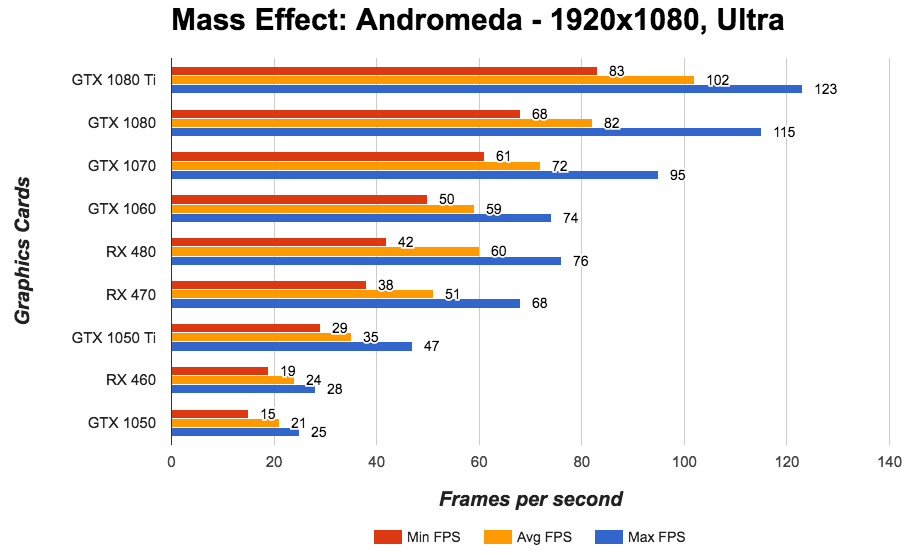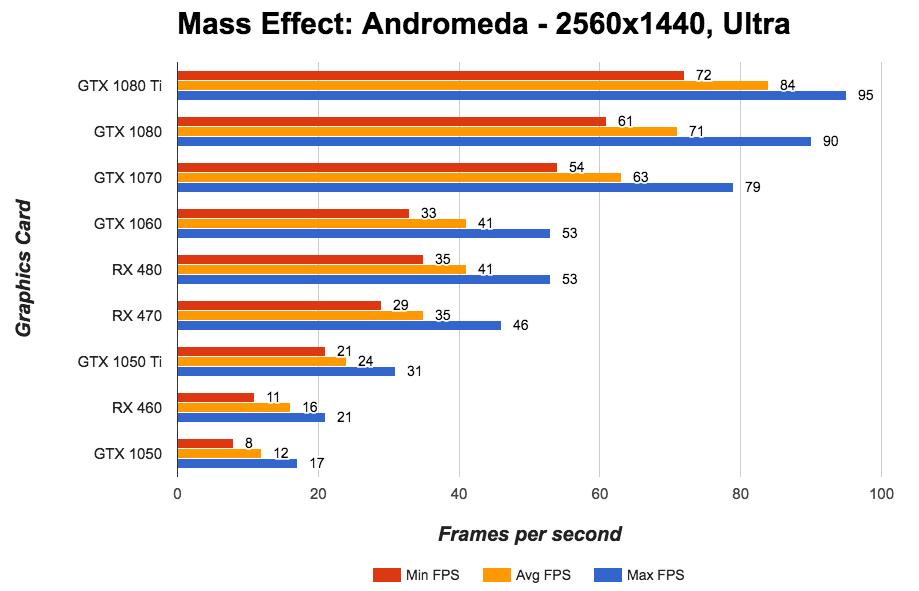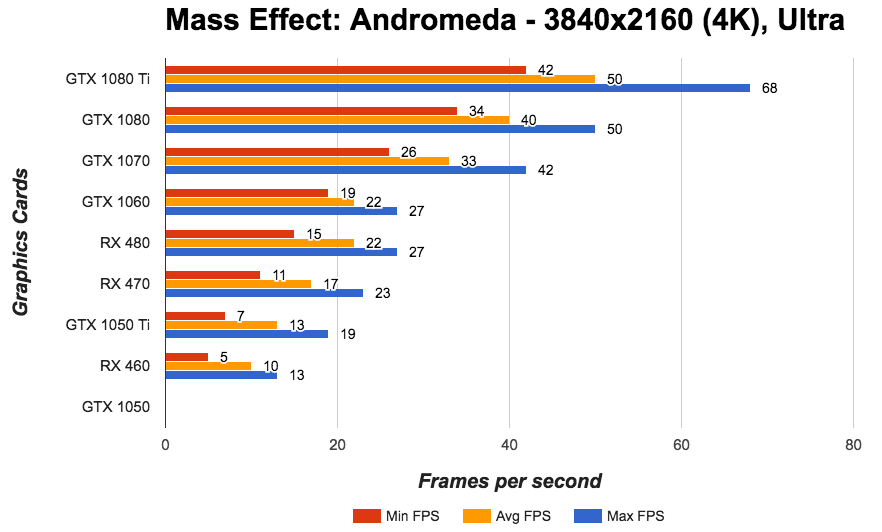Exploring uncharted territories, namely an entirely new galaxy, would be nothing without the visuals to complement grand space-faring. Mass Effect: Andromeda may come up short on some of its character models and animations, but each planet is beautiful and presents a tremendous sense of scale, it’s quite literally out of this world. The game is built with the Frostbite engine, as seen in previous EA titles like Battlefield 1 and Star Wars: Battlefront. It’s a strong foundation to build upon, but how does it perform on the latest graphics cards?
We have nine modern graphics cards from Nvidia and AMD and put them through our own benchmark test. Since Mass Effect: Andromeda does not have a built-in benchmark tool, we used FRAPS--a utility that records frame rate data. We carefully designed a repeatable sequence of events to obtain consistent data that’s indicative of actual gameplay.
Methodology
The benchmark sequence begins outside the Tempest on the starting planet Eos. We had Ryder run through Site 1: Promise, with the camera panning around the environment twice, to where our Nomad was parked. Then, we had Ryder hop into the Nomad to drive up a hill and off a ramp to a short firefight with three enemy Kett. The sequence spanned 90 seconds, after which FRAPS gave us the minimum, average, and maximum FPS during that time frame.

We decided to repeat the process across three resolutions: 1920x1080 (1080p), 2560x1440 (1440p), and 3840x2160 (4K). Field of view was set to the halfway point on the slider and V-Sync was turned off. The “Ultra” preset in the graphics options was used across the board, which includes the following settings:
- Temporal anti-aliasing
- HBAO+ (horizon-based ambient occlusion)
- “Ultra” texture filtering (anisotropic filtering)
- “Ultra” texture, post-processing, shadow, and mesh quality
- “High” effects and lighting quality
- 1.00 resolution scale (resolution scale mode “off”)
The game allows resolution scaling if you need better performance; you can choose between 1080p, 900p, and 720p. This lets your display stay at its native resolution and keeps UI elements the same, but renders the game at which ever setting you choose to scale to.
To see a graphics comparison across all platforms--PC, PS4, and Xbox One--check out our video. And if you need a walkthrough or reminder of what some of these graphics options mean, don’t hesitate to read our PC graphics settings explainer.
Test Bench
As with our previous benchmark stories with For Honor and Ghost Recon: Wildlands, we used a system equipped with an Intel Core i7-6700K clocked at 4.0GHz on a Gigabyte G1 Z170 motherboard. The system also has 16GB of HyperX Savage DDR4 RAM (2133MHz) and a Western Digital Blue solid-state drive. The following is a list of the graphics cards we used for these tests:
- Nvidia GTX 1080 Ti (Reference 11GB)
- Nvidia GTX 1080 (Reference 8GB)
- Nvidia GTX 1070 (Reference 8GB)
- Nvidia GTX 1060 (Reference 6GB)
- Nvidia GTX 1050 Ti (EVGA SC 4GB)
- Nvidia GTX 1050 (MSI OC 2GB)
- AMD RX 480 (Reference 4GB)
- AMD RX 470 (XFX Triple-X 4GB)
- AMD RX 460 (XFX 4GB)
Both Nvidia and AMD released new drivers the week of Mass Effect: Andromeda’s release, so we made sure to use the latest software--Nvidia’s GeForce 378.92 WHQL drivers and AMD’s Radeon Crimson ReLive 17.3.3 package.
Benchmark Results
1080p Results

Nvidia’s top three graphics cards handle 1080p admirably with all graphics settings maxed out. Both mid-range cards--the GTX 1060 and RX 480--held up well through our benchmark by pumping out playable frame rates. The RX 480 even inched ahead of the GTX 1060 by hitting a 60 FPS average, despite dipping to a lower minimum frame rate. These two cards typically perform similarly, and Mass Effect: Andromeda is no exception.
Things get a little dicey as we go down the line to lower-end graphics cards. The RX 470 is able to uphold a 51 FPS average, but the GTX 1050 Ti struggles slightly by only getting out 35 FPS on average and dipping below 30 FPS at one instance. The RX 460 and GTX 1050 aren’t intended to run maximum settings on modern games, even at 1080p, and Andromeda is a clear example of that. Frame rates were understandably low, but the GTX 1050 had several hitches and stutters during the test, which could be attributed to its shortage of VRAM. We’d recommend going down to the “Medium” quality preset to attain playable frame rates.
1440p Results

Both the GTX 1080 Ti and GTX 1080 have no problem handling Andromeda as we move up to 1440p. However, the GTX 1070 dipped under 60 FPS on a few occasions but largely performed well enough to generate a smooth experience.
There’s a significant drop-off in performance once we get to the GTX 1060 and RX 480, but an average of 41 FPS is still considered playable. And again, both cards perform nearly identical here. The RX 470 continues to impress for a lower mid-range card and puts up over 30 FPS on average. At 1440p, it essentially performs just like the 1050 Ti does at 1080p.
The rest of the lower end cards aren’t going to give you smooth framerates at 1440p, and that’s okay considering their price and the demand of Andromeda’s visuals. If you happen to run 1440p natively and you’re equipped with these cards, we’d recommend turning down settings to medium and turning off some special effects. You can also have the game downscale to to 1080p or 900p.
4K Results

It’s not much of a surprise to see nearly every card falter at 4K on “Ultra” settings, though the GTX 1080 Ti can provide a very playable experience by never dipping under 40 FPS through our entire benchmark. The GTX 1080 is no slouch either by staying above 30 FPS. If you’re hoping to do 4K with a GTX 1070, we’d recommend turning down anti-aliasing and setting the quality to “High” instead.
Again, the RX 480 and GTX 1060 are indistinguishable, though it doesn’t matter much at these settings as they both yield unplayable results. Turning off anti-aliasing and going down to “High” or “Medium” settings could make for playable frame rates at 4K.
All the other cards made gameplay near impossible, and therefore benchmarking difficult. However, keep in mind that these cards are not intended to run games at 4K, let alone maximum settings. For instance, the GTX 1050 could not run at all.
Conclusion
Based on our own benchmarks for Mass Effect: Andromeda, performance across our nine graphics cards was not out of the ordinary. Considering all the graphics settings that encompass the “Ultra” preset, the game runs exceptionally well. It shouldn’t come as a surprise since Battlefield 1 and Star Wars: Battlefront used the Frostbite engine; both look incredible and don’t ask too much of your hardware.
If you plan on unraveling the Andromeda galaxy in 4K, you’ll at least want a GTX 1070 in your system. Mid-range cards like the GTX 1060 and RX 480 had a relatively strong showing in 1080p and 1440p, though there’s still plenty of eye candy if you turn down some settings in exchange for better frame rates. Thankfully, the breadth of graphics options lets you tweak the game to find the best balance between performance and visual fidelity.
Regardless of what you think of the animation and character models, the Mass Effect: Andromeda looks stunning, and it has some of the best looking environments and backdrops to date.







